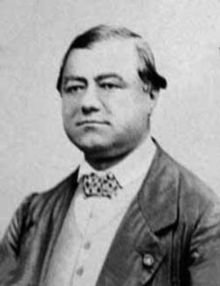Charles Eugène Delaunay
Charles Eugène Delaunay (born April 9, 1816 in Lusigny-sur-Barse near Troyes , † August 5, 1872 near Cherbourg ) was a French mathematician and astronomer .
Life
Delaunay studied with Jean-Baptiste Biot at the Sorbonne in Paris . His work deals with celestial mechanics and the three-body problem . He applied the results to the moon as a special case. Its series development for the representation of the position of the moon converged too slowly to be of any practical use. However, Delaunay's considerations contributed to the development of functional analysis in the 19th century .
In 1855 he became a member of the Académie des Sciences . In 1866 Delaunay was elected to the American Academy of Arts and Sciences and in 1869 as a foreign member ("Foreign Member") in the Royal Society . In 1870 he received the gold medal from the Royal Astronomical Society in London . In the same year he became director of the Paris observatory . In 1871 he was accepted as a corresponding member of the Russian Academy of Sciences in Saint Petersburg .
Charles Eugène Delaunay died on August 5, 1872 in a shipwreck in the port of Cherbourg.
His name is immortalized on the Eiffel Tower, see: The 72 names on the Eiffel Tower . The Delaunay lunar crater is named after him.
Publications
- Cours élémentaire de mécanique . ( 1850 )
- Traité de mécanique rationnelle . ( 1856 )
- La Théorie du mouvement de la lune . 2 vols. ( 1860 - 7 )
Individual evidence
- ^ Foreign members of the Russian Academy of Sciences since 1724. Charles Eugène Delaunay. Russian Academy of Sciences, accessed August 26, 2015 .
Web links
- Publications by C.-E. Delaunay in the Astrophysics Data System
- ED: Charles Eugène Delaunay Monthly Notices of the Royal Astronomical Society, Volume 33 (1873), pp. 203-209 (obituary, English)
- Entry for Delaunay, Charles Eugene (1816-1872) in the Archives of the Royal Society , London
| personal data | |
|---|---|
| SURNAME | Delaunay, Charles Eugène |
| BRIEF DESCRIPTION | French mathematician and astronomer |
| DATE OF BIRTH | April 9, 1816 |
| PLACE OF BIRTH | Lusigny-sur-Barse , France |
| DATE OF DEATH | August 5, 1872 |
| Place of death | Cherbourg |
